Textural Touches: Adding Warmth & Personality to Your Bathroom Decor
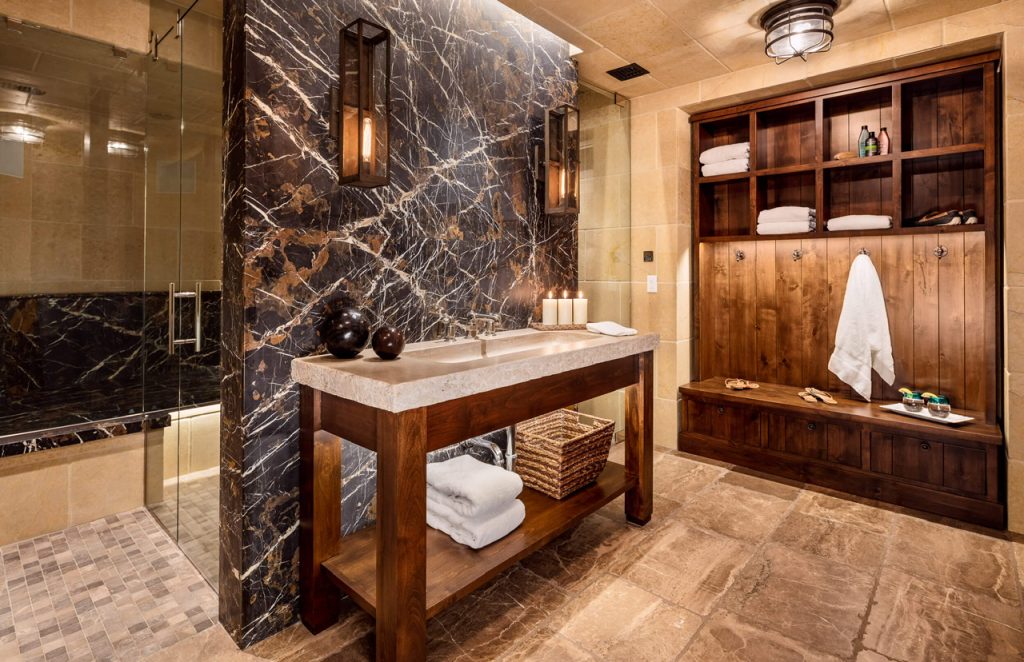
The modern bathroom has evolved far beyond its utilitarian roots. No longer merely a functional space, today’s bathrooms serve as personal sanctuaries—places to begin and end our days in comfort and style. Yet many bathrooms still suffer from a common design flaw: an overabundance of sleek, hard surfaces that create a clinical atmosphere rather than a welcoming retreat.
The secret to transforming any bathroom from sterile to stunning lies in the thoughtful application of texture.T exture adds depth, dimension, and visual interest to a space that often defaults to smooth porcelain and gleaming chrome.
By introducing varied textures through materials, patterns, and layering techniques, you can create a bathroom that feels as good as it looks—a space that soothes the senses and reflects your personal style. Here’s how to bring tactile richness to this often-overlooked room.
The Wall Renaissance

The largest surfaces in your bathroom offer the greatest opportunity for textural impact. Moving beyond flat painted drywall can dramatically alter the room’s character.
Architectural wall treatments like shiplap, beadboard, or board-and-batten paneling instantly add dimensional interest while evoking coastal or farmhouse charm. These treatments create shadow lines that change throughout the day as light shifts across the room. They’re also surprisingly practical in bathrooms since many come in moisture-resistant versions.
For those seeking luxury with an artisanal touch, Venetian plaster provides subtle dimension with its characteristic depth and luminosity. Applied by hand, each installation is uniquely textured, creating walls that seem to glow from within.
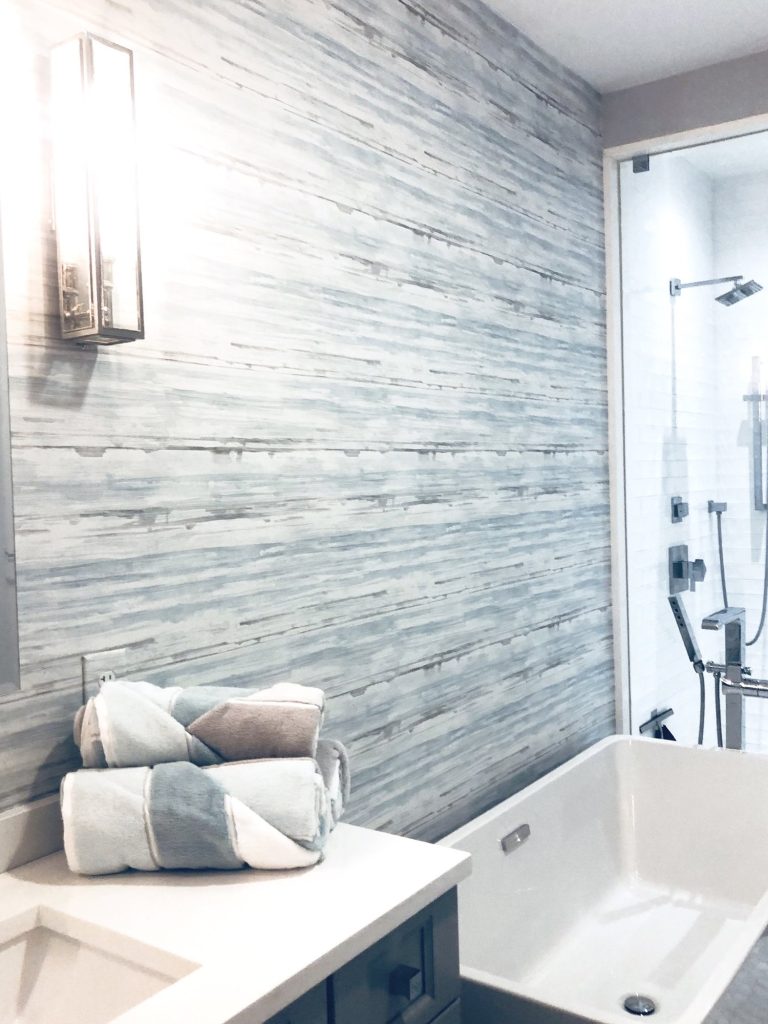
Wallpaper has also made a triumphant return to bathrooms, with manufacturers now offering water-resistant options in richly textured finishes. Grasscloth wallpaper brings natural fiber texture, while embossed patterns create tactile dimension even in smaller powder rooms.
Stone’s Timeless Appeal
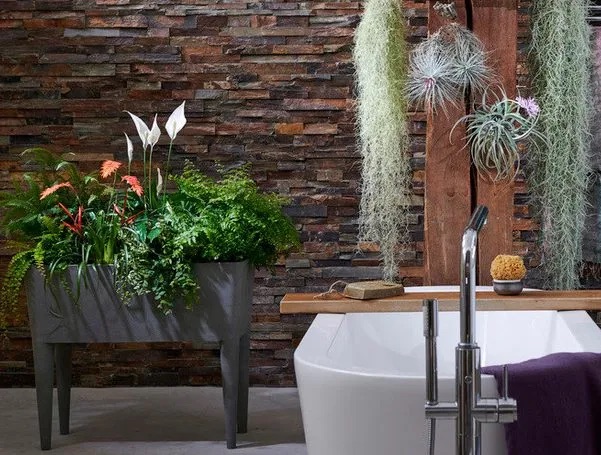
Natural stone speaks the language of luxury while delivering unmatched textural variety. From the rustic character of slate to the sophisticated veining of marble, stone elements ground the bathroom in organic beauty.
The bathroom is actually the perfect showcase for stone’s natural variation. Water amplifies the depth of stone surfaces, particularly in shower areas where the stone can reveal new details when wet.
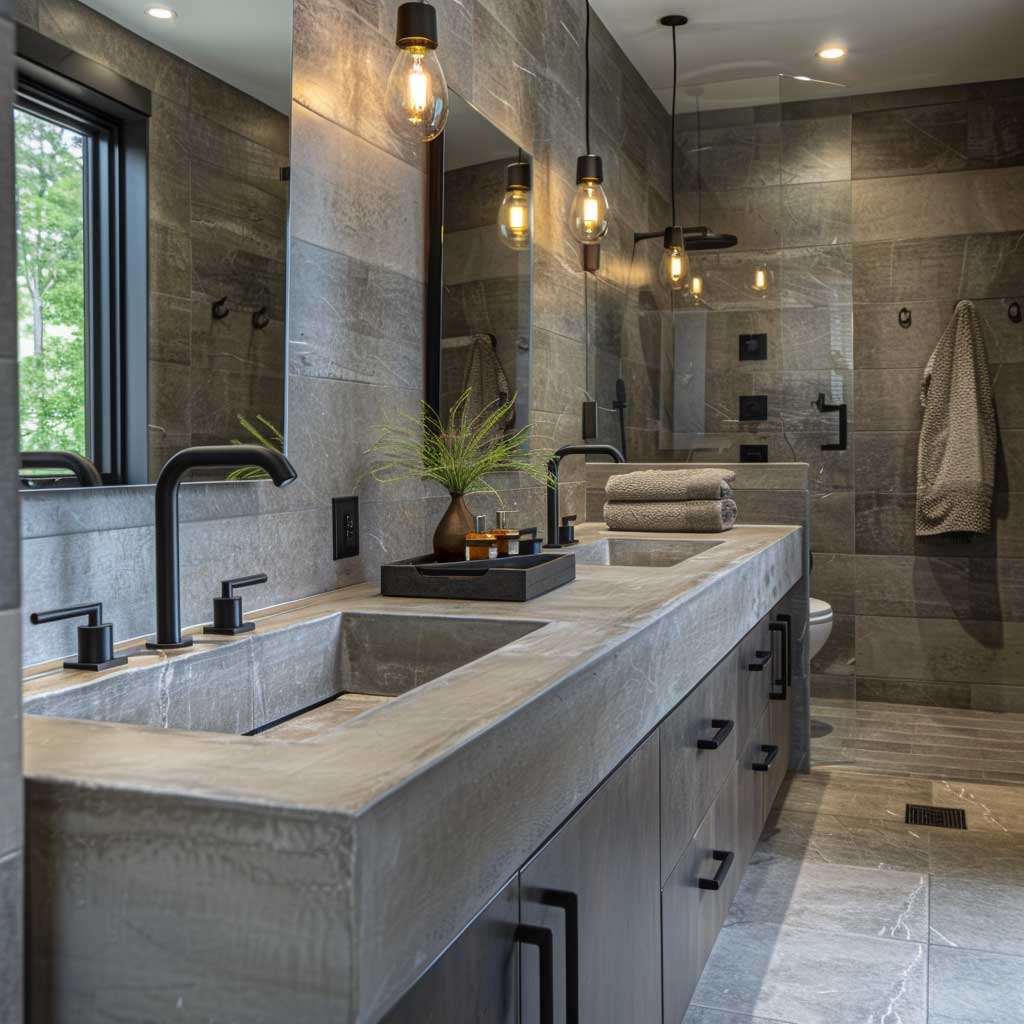
Beyond traditional applications like cement countertops, consider a pebble shower floor that massages feet while creating visual contrast against smoother surfaces. Or make a dramatic statement with a full accent wall of stacked stone—creating a spa-like focal point that transforms the entire room.
The Warmth of Wood
Nothing counters the inherent coolness of bathroom surfaces quite like the warmth of wood. Once avoided due to moisture concerns, wood has reclaimed its place in bathroom design through clever applications and improved finishes.
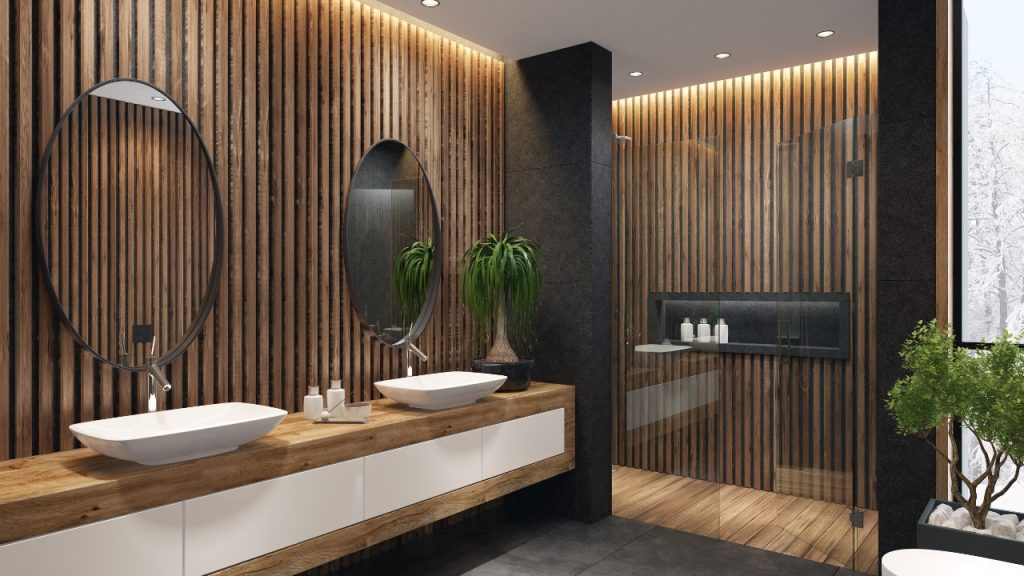
A teak shower bench serves both practical and aesthetic purposes, offering a place to rest while introducing organic texture. Wood vanities—particularly those with visible grain patterns or live edges—become functional art pieces in bathroom settings.
For those concerned about wood in wet environments, wood-look porcelain tiles deliver the visual texture without maintenance worries. These tiles have become so sophisticated that you need to touch them to confirm they’re not actual wood. They’re perfect for creating that textural warmth without the worry.
Textile Transformations
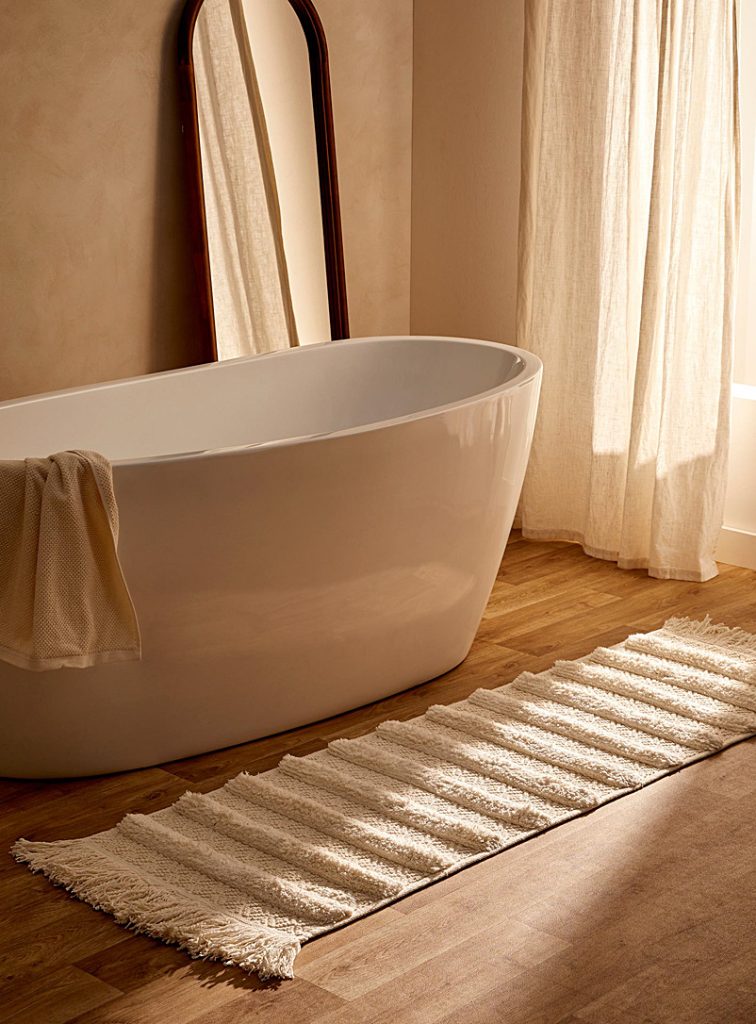
Bathroom textiles offer perhaps the simplest way to introduce texture, yet they’re often reduced to basic cotton towels and bath mats. Expanding your textile horizons transforms both the look and feel of the space.
Replace standard bath mats with plush, high-pile options or woven wool rugs that bring living room comfort to bathroom floors. Trade ordinary towels for Turkish peshtemal varieties with their characteristic fringe and subtle patterns, or waffle-weave options that create dimensional interest even when folded.
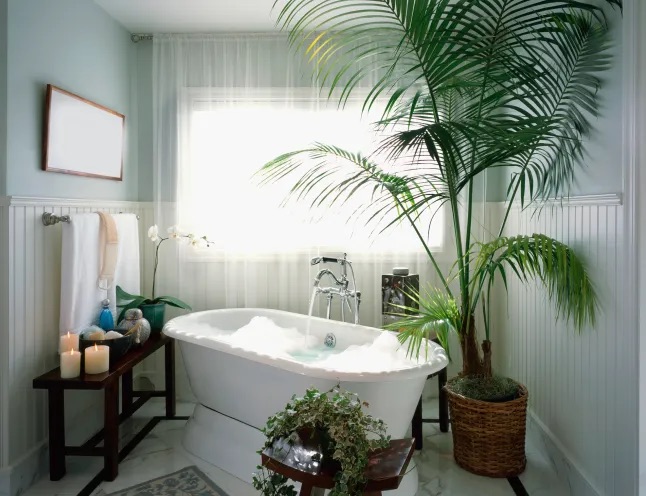
Window treatments and shower curtains present additional opportunities for textile texture. Linen options bring casual elegance with their characteristic slubby texture, while woven cotton or hemp varieties add organic character that softens the room’s harder elements.
Woven Wonders
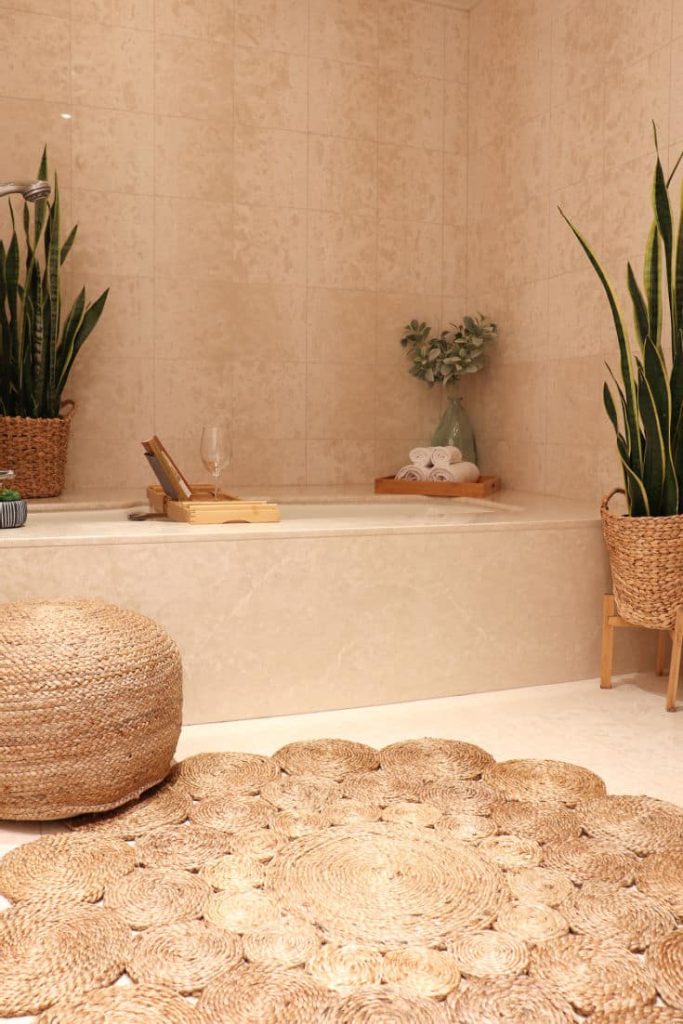
Woven materials offer a perfect textural counterpoint to the sleek surfaces dominating most bathrooms. Baskets perform double-duty as both storage solutions and textural decor—storing towels, toiletries, or toilet paper while adding visual warmth.
Rattan, seagrass, and water hyacinth bring natural variation that feels especially refreshing in bathrooms. Their irregular patterns and subtle color variations create visual texture even from across the room.
Consider incorporating woven pendant lights, mirror frames, or even chair seats to elevate the bathroom with artisanal character that feels simultaneously sophisticated and down-to-earth.
The Tile Revolution
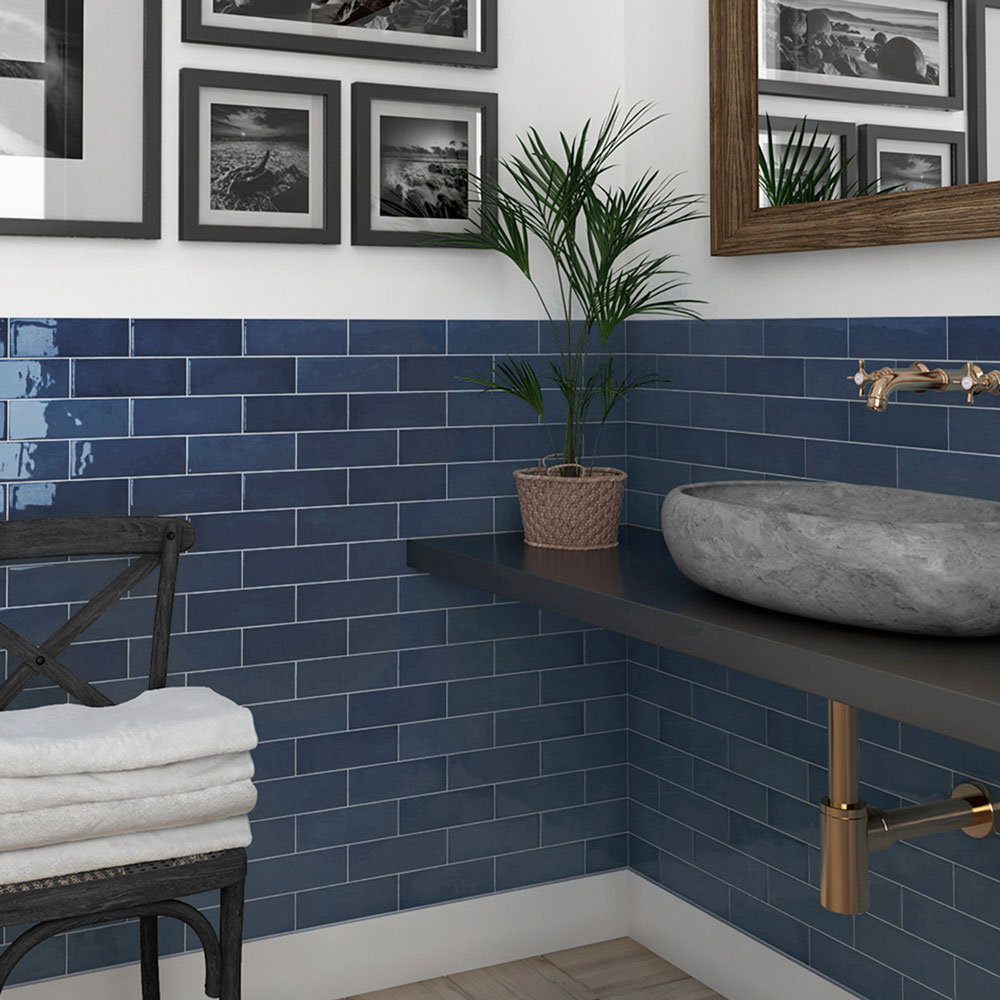
The humble bathroom tile has undergone a remarkable evolution, emerging as a primary vehicle for introducing texture. Moving beyond flat, glossy subway tiles, today’s options include handmade varieties with subtle irregularities that catch light in unpredictable ways.
Zellige tiles from Morocco feature characteristic variations in thickness, color, and sheen that create surfaces with unmatched visual depth. Three-dimensional tiles with geometric patterns transform walls into sculptural installations that change dramatically as lighting shifts throughout the day.
Even the finish makes a textural difference. Matte or honed finishes have a velvety quality that softens the bathroom. They’re more forgiving with water spots while creating a more contemporary feel than traditional glossy options.
Character Through Patina
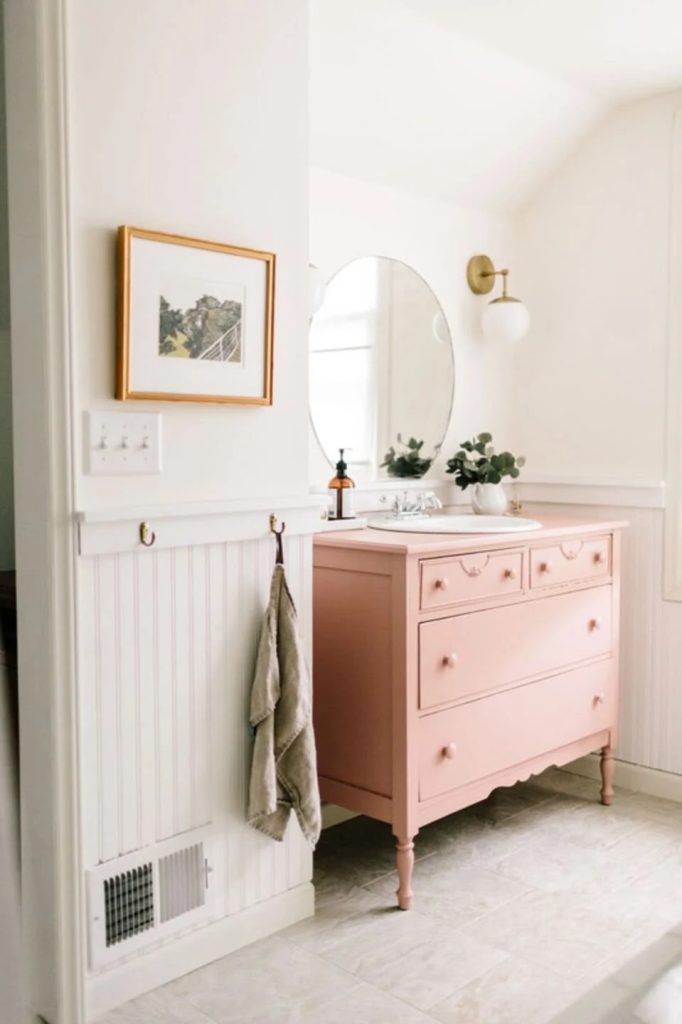
Nothing adds texture quite like time—or the appearance of it. Incorporating vintage or weathered elements brings instant character and textural richness to even the newest bathroom.
An antique mirror with subtle foxing (those characteristic black spots) creates dimensional interest while reflecting light. Fixtures with living finishes like unlacquered brass develop patinas uniquely shaped by use and exposure, becoming more textured and characterized over time.
Reclaimed wood, whether as vanity material or decorative accents, brings unmatched textural variation through its weathered surfaces, nail holes, and growth patterns—telling stories through its very texture.
Living Texture
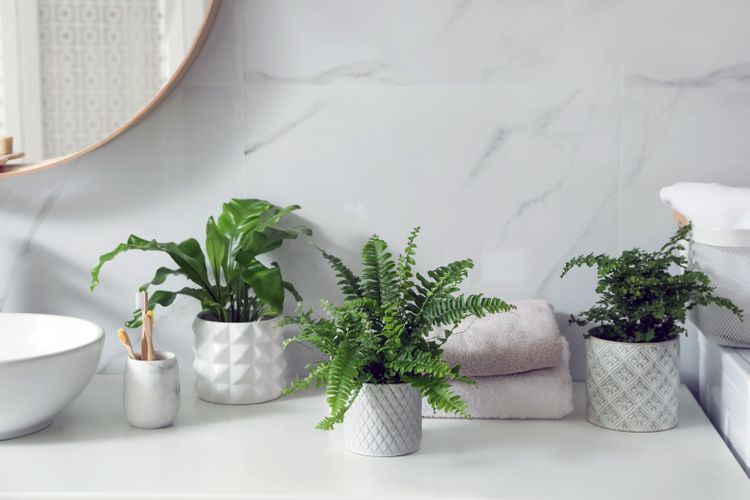
Plants introduce perhaps the most dynamic texture of all—one that changes, grows, and responds to its environment. From the feathery fronds of ferns to the structural solidity of snake plants, bathroom greenery brings multisensory texture through visual pattern, physical touch, and even subtle movement.
Bathrooms often provide ideal growing conditions for many plants. The humidity benefits tropical varieties, and their organic texture creates a perfect balance against the bathroom’s harder elements.
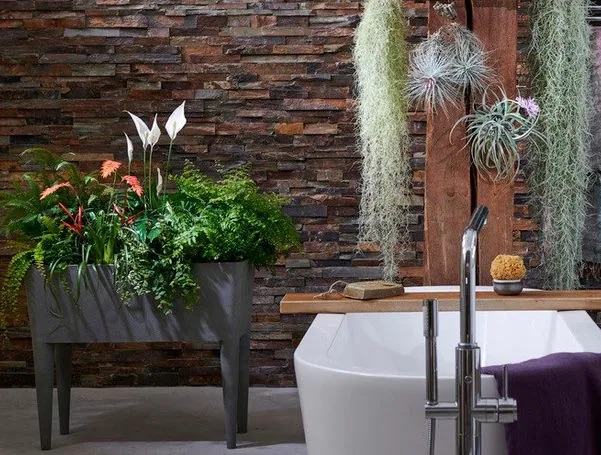
For those with limited space, small shelf plants or hanging varieties maximize impact while minimizing footprint. More ambitious designers might consider a preserved moss wall or vertical garden installation for a truly immersive textural experience.
Artisanal Accents
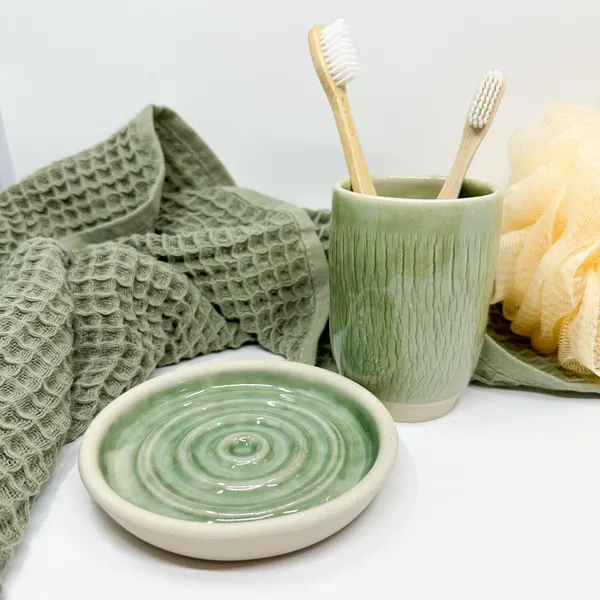
Handcrafted accessories offer concentrated texture in small packages. Artist-made ceramic soap dishes, stone trays, and carved wooden accessories bring tactile interest to everyday objects while elevating the bathroom’s overall design sensibility.
Look for pieces that invite touch. The best bathroom accessories engage multiple senses—feeling as good in the hand as they look to the eye.
Consider grouping textural accessories in small vignettes—perhaps a handwoven basket holding hand towels beside a carved stone diffuser—creating moments of textural dialogue that draw the eye and hand.
Metal Moments
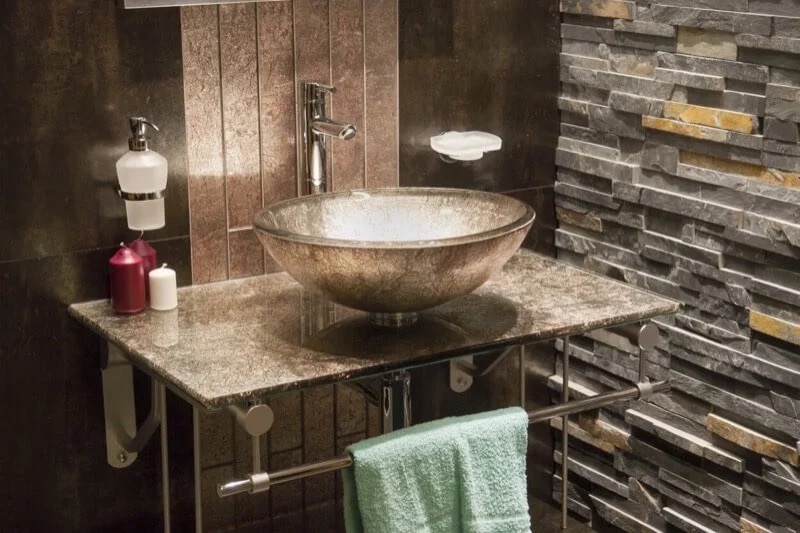
Metal elements typically default to chrome in bathrooms, but expanding your finish palette creates new opportunities for textural interest. Brushed nickel offers subtle linear texture, while hammered copper combines visual pattern with a living finish that evolves over time.
The true magic happens when metals interact with other materials. The contrast between materials creates its own kind of texture. A smooth marble countertop against aged brass fixtures creates a textural conversation that neither element achieves alone.
Even utilitarian storage can contribute texture through wire baskets, perforated metal shelving, or mesh containers that add visual rhythm while keeping necessities at hand.
Illuminating Texture
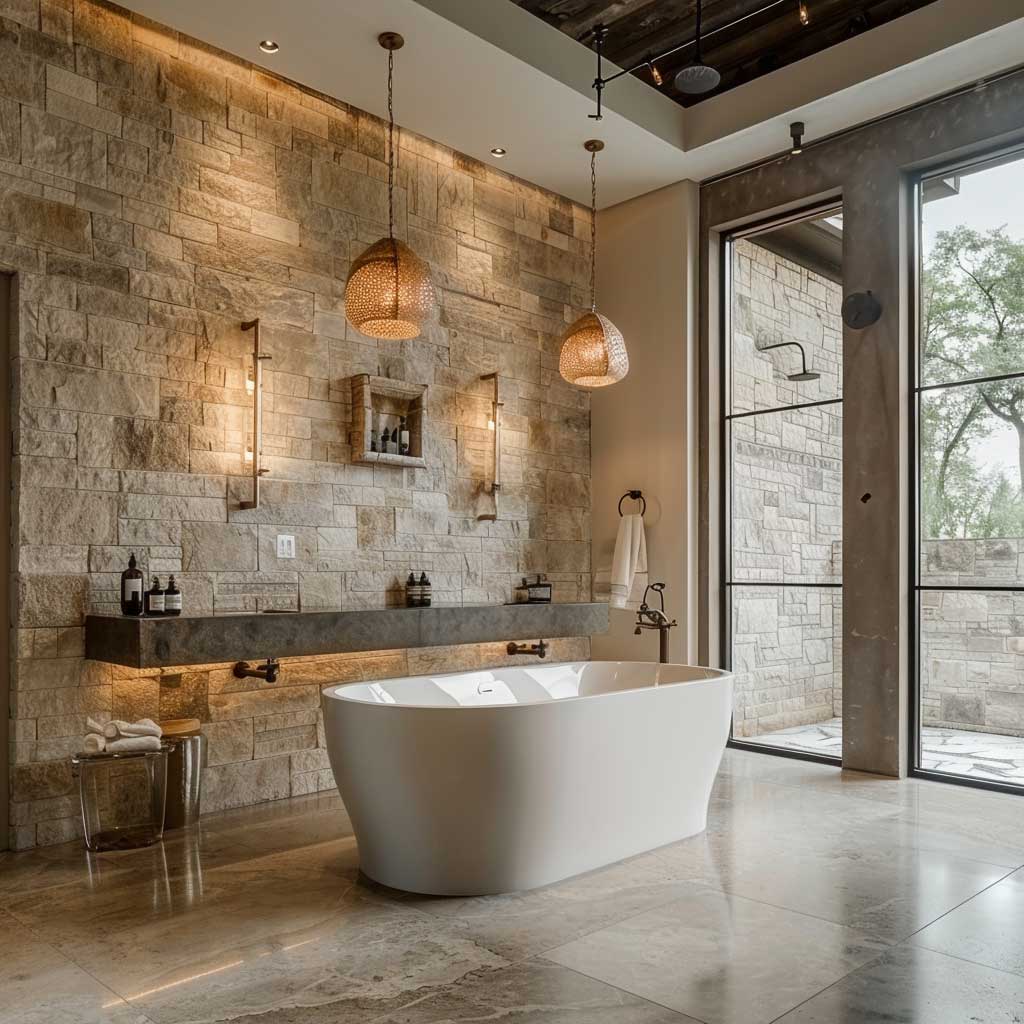
Lighting affects how we perceive texture, but it can also introduce texture itself. Replace basic bathroom fixtures with options that feature textural elements—perhaps a pendant with a woven shade or sconces with ribbed or frosted glass.
Lighting creates shadows, and shadows are what make texture visible. Directional lighting strategically placed can dramatize textural elements, making them more pronounced at different times of day.
Even humble candles contribute to the textural landscape, their flickering flames creating moving shadows that animate surrounding surfaces while their varied containers—perhaps concrete, hammered metal, or textured ceramic—add concentrated moments of tactile interest.
The Layered Approach

The most successful textural bathrooms employ not just individual elements but thoughtful combinations. Texture works best in conversation. It’s about creating a dialogue between rough and smooth, matte and glossy, geometric and organic.
The key lies in balance—allowing certain textural elements to stand out while others recede, creating a hierarchy that guides the eye through the space. Too many competing textures create visual chaos; too few miss the opportunity for dimensional richness.
By thoughtfully layering textural elements throughout your bathroom, you create a space that engages the senses, invites exploration, and feels distinctly personal—a true retreat from the smooth, screen-dominated world outside. In the realm of bathroom design, texture isn’t just a decorative afterthought—it’s the essential ingredient that transforms function into feeling, utility into sanctuary.
10 Unusual and Inexpensive Textural Accessories for Your Bathroom
Let’s be honest—making your bathroom feel unique and cozy without blowing your budget is tough. But honestly, adding a little texture here and there with small accessories can totally shift the vibe.
The right textural accessories can give your bathroom more depth, warmth, and personality without costing much. Even tiny, affordable changes can make your space more inviting for anyone who steps inside.
Sage Chenille Bath Rugs
If you want a soft spot to land after a shower, H.VERSAILTEX sage chenille bath rugs might be exactly what you need. These rugs feel thick and gentle under your feet.
The sage color is calming and works with a bunch of different styles. You’ll notice the chenille fabric right away—it’s plush and shaggy, keeping your feet warm and cozy.
This extra softness makes stepping out of the tub so much nicer. The non-slip backing keeps the rugs in place, so you don’t have to stress about slipping on tile.
Just toss them in the washing machine when they need cleaning. They soak up water well, so your bathroom floor won’t stay wet for long.
The price is reasonable, and the look is classic. It’s a small upgrade that feels surprisingly good every day.
Peel-and-Stick Vinyl Shower Wall Tiles
If you want a quick change in your shower, peel-and-stick vinyl tiles are a solid pick. These tiles come in so many styles—classic subway, marble, stone, you name it.
No special tools or grout are needed. You just measure, cut, peel, and stick. Even first-timers can pull this off.
These tiles are waterproof, so go ahead and use them inside your shower. Just make sure your wall is clean and smooth for the best stick and long-lasting results.
They cost way less than real tile or stone, and you can swap them out easily if you want a new look later. Some folks use a hairdryer to help the tiles stick even better.
If you’re renting or just want a temporary change, peel-and-stick tiles are a clever fix. You get a unique bathroom without a big spend or major commitment.
Black Marquina Marble Soap Dish
A Black Marquina marble soap dish brings a bold, modern touch to your bathroom. The marble is dark with natural white veins, so every dish has its own pattern.
If you like sturdy things, you’ll appreciate how solid and cool this dish feels. Marble keeps its shape for years, and the polished finish wipes clean with a damp cloth.
The black-and-white look fits in with almost any decor, whether your bathroom is bright or neutral. Some Black Marquina dishes are hand-carved, so each one is a little different.
The smooth texture feels nice to hold, and the weight keeps it steady on your sink or tub. Since it’s made from real stone, it adds a bit of luxury without a big price tag.
If you want something useful that stands out from basic plastic trays, this one’s worth a look.
Handcrafted Wooden Bath Tray
A handcrafted wooden bath tray adds style and function to your bathroom. It sits across your tub and holds things like a book, candle, or even a cup of tea.
You can pick trays made from bamboo, walnut, reclaimed pine—each has its own look and feel. Wood brings a warmth and natural vibe you just don’t get from plastic or metal.
Most wood bath trays handle bathroom humidity well, as long as you keep them dry between uses. Some even have slots for your phone or a wine glass, which is a nice touch.
Buying a handmade tray supports small businesses and artisans, too. You might find unique, custom designs online or at local craft fairs.
It’s easy to move and store, and you only need it on the tub when you want. You could even use it as a decorative piece on a shelf. Bath time just feels a bit more special with one of these.
Woven Seagrass Storage Baskets
Woven seagrass baskets make your bathroom look cozy and organized at the same time. The natural texture softens the space and works with most styles.
Use these baskets for towels, toiletries, or even laundry. They keep things tidy without looking boring. Many have cutout handles, so you can move them around easily.
Seagrass baskets are light but sturdy enough for daily use. Their simple colors blend with modern, rustic, or coastal themes.
Since they’re handwoven, each basket has its own character. Try one on a shelf for washcloths or tuck a set under the sink for extra toilet paper.
They work well in small spaces and help your bathroom feel calm and welcoming. You can find all kinds of sizes and shapes, so there’s something for everyone.
Textured Ceramic Toothbrush Holder
A textured ceramic toothbrush holder adds style and function to your bathroom. The surface stands out compared to plain plastic or metal holders.
Some have dot detailing or a reactive glaze that makes each one unique. The handmade touch gives a cozy feel and fits rustic or modern themes.
Creamy white or matte finishes blend easily with many bathroom styles. Ceramic is sturdy and easy to clean, since it resists chipping and staining better than some other materials.
You might pick a holder inspired by natural shapes, like rocks or mountains, for a creative twist. Even small accessories like this make your bathroom feel more personal.
Prices are usually reasonable, especially online or at big stores. Handmade options on Etsy offer something truly special if you want a one-of-a-kind piece.
Jute Twine Wrapped Toilet Paper Holder
A jute twine wrapped toilet paper holder brings a warm, rustic feel to any bathroom. The rough texture of jute gives your space a cozy, handmade look.
You can find jute-covered holders online or make one yourself with some rope and glue. All you need is a basic holder, some natural jute twine, and a little patience.
Just wrap the twine tightly around the holder, gluing it as you go. It’s a simple project that doesn’t take much time.
Jute is sturdy and eco-friendly. It matches farmhouse, coastal, or boho décor, and you can add little touches like knots or loops for extra style.
If DIY isn’t your thing, check out handmade options at craft shops or online marketplaces. Some come with extras like a hanging loop or basket design.
Swapping your basic holder for a jute-wrapped one is a quick way to bring more texture and charm to your bathroom. It’s an easy, affordable update that stands out in a subtle way.
Small Potted Succulent Plants
Adding small potted succulents to your bathroom brings a fresh, lively touch. These plants are perfect for small spaces and don’t need much care.
Their interesting shapes and colors create fun texture without taking up much room. You can find succulents that stay tiny, usually under six inches tall.
Options like Haworthia, living stones, or mini cacti fit easily on shelves, window sills, or by the sink. Their thick leaves and unique patterns add visual interest wherever they go.
Succulents love the natural humidity in bathrooms, which keeps them happy. They only need a little water and some indirect light.
Pick a few different types in small pots to bring even more texture and color. Their simple care and space-saving size make them an easy, stylish accessory for any bathroom.
Striped Pattern Shaggy Bath Mats
If you want to add texture and color to your bathroom, striped pattern shaggy bath mats are a fun option. The stripes give your space a playful touch without being too loud.
Most are made from soft, thick microfiber or chenille. They feel comfy under your feet, and the shaggy surface adds warmth when you step out of the shower.
These mats soak up water well, so your bathroom floor stays dry. Many have non-slip backing to keep them in place and help prevent slips.
The mix of colors in the stripes can match almost any style. You’ll find plenty of sizes and color combos, so it’s easy to pick one that works for you.
Most shaggy mats are easy to care for—just toss them in the washing machine when they need it. Adding one of these mats is a simple, budget-friendly way to give your bathroom a soft and stylish update.
Coastal Driftwood Wall Hooks
Want to bring a bit of the beach into your bathroom? Try driftwood wall hooks.
These hooks use real driftwood, so each one ends up looking a little different. The natural shape and texture give your space that relaxed, coastal vibe.
The weathered wood feels soft and smooth—kind of like it’s been shaped by years of gentle waves. It’s a quiet reminder of calm days by the water, which sounds pretty nice, honestly.
Hang towels, robes, or even keys if your bathroom’s near the entryway. You can pop these hooks up on almost any wall, and they fit especially well with a coastal or natural theme.
Since every piece of driftwood is unique, you won’t find two hooks that look exactly the same. That’s the kind of detail you just can’t get from mass-produced decor.
Making your own driftwood hooks? That can be a fun afternoon project. Just sand down the wood, attach some sturdy hardware, and you’re all set.
Driftwood wall hooks do more than just hold your stuff—they add a bit of art to your bathroom. And honestly, you don’t have to spend much to get that peaceful, beachy look.
